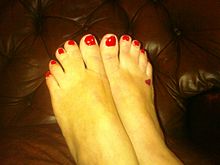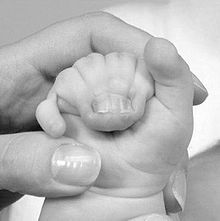- Syndactyly
-
Syndactyly Classification and external resources
New born baby hand showing complete complex syndactyly of two fingers.ICD-10 Q70 ICD-9 755.1 OMIM 185900 186100 186200 186300 DiseasesDB 29330 MedlinePlus 003289 eMedicine orthoped/563 MeSH D013576 Syndactyly (from Greek συν- = "together" plus δακτυλος = "finger") is a condition where two or more digits are fused together. It occurs normally in some mammals, such as the siamang and kangaroo, but is an unusual condition in humans.
Contents
Classification
Syndactyly can be simple or complex.
- In simple syndactyly, adjacent fingers or toes are joined by soft tissue.
- In complex syndactyly, the bones of adjacent digits are fused. The kangaroo exhibits complex syndactyly.
Syndactyly can be complete or incomplete.
- In complete syndactyly, the skin is joined all the way to the tip of the finger
- In incomplete syndactyly, the skin is only joined part of the distance to the fingertip.
Complex syndactyly occurs as part of a syndrome (such as Apert syndrome) and typically involves more digits and with complex syndactyly.
Fenestrated syndactyly means the skin is joined for most of the digit but in a proximal area there is gap in the syndactyly with normal skin. This type of syndactyly is found in amniotic band syndrome.
Simple syndactyly can be full or partial, and is present at birth (congenital). In early human fetal development, webbing (syndactyly) of the toes and fingers is normal. At about 16 weeks of gestation, apoptosis takes place and an enzyme dissolves the tissue between the fingers and toes, and the webbing disappears. In some fetuses, this process does not occur completely between all fingers or toes and some residual webbing remains.
Genetics
Five types[1] of syndactyly have been identified in humans. The corresponding loci associated with these types and their common phenotypical expression are as follows:
- type I: 2q34-q36;[2] webbing occurs between middle and ring fingers and/or second and third toes.
- type II: 2q31;[3] also involves long and ring fingers, but has a sixth finger merged in between.
- type III: 6q21-q23; small finger is merged into the ring finger.
- type IV: 7q36;[4] involves all fingers and/or toes
- type V: 2q31-q32; similar to type I, but the metacarpals and metatarsals may also be fused.
Treatment
4 year old boy's right hand, after surgery to rectify complete complex syndactyly of middle and ring finger. Bone had been joined at tips of fingers, together with fingernails, prior to corrective procedure. Surgery was conducted at 9 months of age. Note webbing "creep", and scar tissue, for which corrective surgery is due when boy is approximately 6 years of age.
Timing
Syndactyly of the border digits (thumb/ index finger or ring/ small fingers) is treated at early age to prevent the larger digit from curving towards the smaller digit with growth. Typically, syndactyly of these digits is treated at 6 months of age. The treatment of syndactyly of the other digits is elective and is more commonly performed when the digits have grown, at 18– 24 months of age.
Techniques
Because the circumference of the conjoined fingers is smaller than the circumference of the 2 separated fingers, there is not enough skin to cover both digits once they are separated at the time of surgery. Therefore, the surgeon must bring new skin into the area at the time of surgery. This is most commonly done with a skin graft (from groin or anterior elbow). Skin can also be used from the back of the hand by mobilizing it (called a "graftless" syndactyly correction) which requires planning over a period of months prior to surgery.
Complications
The most common problem with syndactyly correction is creeping of the skin towards the fingertip over time. This is likely due to tension at the site of the repair between the digits. Additional surgery may be required to correct this. One critique of using skin grafts is that the grafts darken in the years after surgery and become more noticeable. Also, if the skin grafts are harvested from the groin area, the skin may grow hair. Finally, the fingers may deviate after surgery. This is most commonly seen in complex syndactyly (when there has been a bony joining of the fingers).
See also
- Dactyly, the arrangement of fingers and toes in different kinds of animals
References
- ^ Flatt A (1 January 2005). "Webbed fingers". Proceedings (Baylor University. Medical Center) 18 (1): 26–37. PMC 1200697. PMID 16200145. http://www.pubmedcentral.nih.gov/articlerender.fcgi?tool=pmcentrez&artid=1200697.
- ^ Bosse K, Betz RC, Lee YA, et al. (2000). "Localization of a Gene for Syndactyly Type 1 to Chromosome 2q34-q36". Am. J. Hum. Genet. 67 (2): 492–7. doi:10.1086/303028. PMC 1287194. PMID 10877983. http://www.pubmedcentral.nih.gov/articlerender.fcgi?tool=pmcentrez&artid=1287194.
- ^ Sarfarazi, Akarsu, et al. (1995). "Localization of the syndactyly type II (synpolydactyly) locus to 2q31 region and identification of tight linkage to HOXD8 intragenic marker". Hum. Mol. Genet. 4 (8): 1453–8. doi:10.1093/hmg/4.8.1453. PMID 7581388. http://hmg.oxfordjournals.org/cgi/reprint/4/8/1453.pdf.
- ^ Sato D, Liang D, Wu L, et al. (2007). "A syndactyly type IV locus maps to 7q36". Journal of Human Genetics 52 (6): 561–4. doi:10.1007/s10038-007-0150-5. PMID 17476456. http://www.ingentaconnect.com/content/klu/10038/2007/00000052/00000006/00000150.
Congenital malformations and deformations of musculoskeletal system / musculoskeletal abnormality (Q65–Q76, 754–756.3) Appendicular
limb / dysmeliahand deformity:Lowerhip:knee:Genu valgum · Genu varum · Genu recurvatum · Discoid meniscus · Congenital patellar dislocation · Congenital knee dislocationfoot deformity:Either / bothdactyly / digit:Polydactyly / Syndactyly (webbed toes) · Arachnodactyly · Cenani Lenz syndactylism · Ectrodactyly · Brachydactyly (Clubbed thumb)reduction deficits / limb:multiple joints:Axial Craniofacial dysostosis:other:spinal curvature (Scoliosis) · Klippel-Feil syndrome · Spondylolisthesis · Spina bifida occulta · SacralizationThoracic skeletonribs:sternum:M: JNT
anat(h/c, u, t, l)/phys
noco(arth/defr/back/soft)/cong, sysi/epon, injr
proc, drug(M01C, M4)
Categories:- Congenital disorders of musculoskeletal system
Wikimedia Foundation. 2010.




